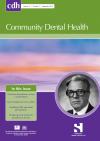Community Dental Health

- Cover Date:
- September 2015
- Print ISSN:
- 0265 539X
- Vol:
- 32
- Issue:
- 3
Exploring the association between oral health literacy and alexithymia
Community Dental Health (2015) 32, 143–147 Received 30 March 2015; Accepted 28 April 2015
doi:10.1922/CDH_3637Stein05
Exploring the association between oral health literacy and alexithymia
L. Stein, M. Bergdahl, K.S. Pettersen and J. Bergdahl
Low health literacy and alexithymia have separately been emphasized as barriers to patient-practitioner communication, but the association between the two concepts has not been explored. Objective: To test the hypothesis that low oral health literacy and alexithymia are associated. Method: Adults (n=127) aged 21-80 years (56% women) participated in this cross-sectional study. Oral health literacy was assessed using the interview-based Adult Health Literacy Instrument for Dentistry (AHLID) with scores from 1-5. The self-administered Toronto Alexithymia Scale (TAS-20) was used to assess three distinct TAS-20 factors and TAS-20 total score. Results: Significant negative correlations between AHLID scores and TAS-20 factors 2, 3 and TAS-20 total score were found. Regression analyses showed that TAS-20 factor 3, externally-oriented thinking (β=-0.21, SE=0.02, p=0.017), and TAS-20 total score (β=-0.18, SE=0.01, p=0.036) were significant predictors of AHLID level. Conclusion: The hypothesis that low oral health literacy is associated with alexithymia was supported. This finding proposes that alexithymia may be considered as a possible factor for low oral health literacy. However, the correlations are not strong, and the results should be regarded as a first step to provide evidence with additional research on this topic being needed.
Key words: alexithymia, health literacy, oral health literacy, patient-practitioner communication, personality, Norway
- Article Price
- £15.00
- Institution Article Price
- £
- Page Start
- 143
- Page End
- 147
- Authors
- L. Stein, M. Bergdahl, K.S. Pettersen, J. Bergdahl
Articles from this issue
- Title
- Pg. Start
- Pg. End
- Relationship between family characteristics and children’s regular toothbrushing with fluoride toothpaste
- 132
- 136
- Effect of family caregiver oral care training on stroke survivor oral and respiratory health in Taiwan: a randomised controlled trial
- 137
- 142
- Association of oral health literacy with oral health behaviour and oral health status in Belarus
- 148
- 152
- Comparing UK, USA and Australian values for EQ-5D as a health utility measure of oral health
- 180
- 184
